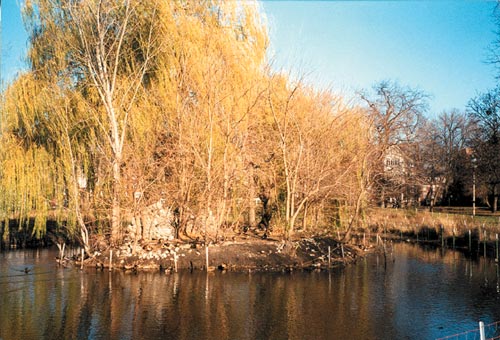Indian Boundary Urban Habitat Restoration |
 Indian Boundary Lagoon Island before construction. Introduction In February of 2001, the Chicago Park District awarded a new contract, Natural Resource Services, to The ServiceMaster Company for management of the Park District’s forty-six natural areas, including prairies, wetlands, lagoons, savannas, river edges, and woodlands. ServiceMaster assembled a team of natural resource experts including Integrated Lakes Management (ILM) and Conservation Design Forum, Inc. (CDF). ILM provides aquatic management expertise including diagnostic testing and consulting, while CDF provides ecological restoration and management expertise. Services also provided in this contract include natural area and habitat assessments in addition to new restoration projects. Indian Boundary Park, located on Chicago’s far north side, was among the first in line for restoration. Background The lagoons north shoreline had similar problems. Several renegade access points left eroding bare spots along the emergent plant zone. Invasive non-native plant species were encroaching on the few native species present in the narrow upland buffer areas. Herbivorous waterfowl also prevented the establishment of native plant species. According to ILM’s year 2000 Water Quality Report; excessive erosion, bare soils, undesirable fish species, and shallow pond depth contributed to a very high total suspended solids (TSS) value of 110 mg/l. The pond water was very turbid. TSS values greater than 25 mg/l are considered “highly impaired” as graded by Illinois Environmental Protection Agency (EPA) Lake Assessment Criteria (1992). Related to TSS is the secchi depth which is a measure of water clarity. Secchi depths less than 1.5 feet are also indicative of lake use impairment. Last year Indian Boundary’s secchi depth was 0.25 feet. Add to that an elevated fecal coliform count (an indirect measure of animal waste) of 1,750 counts per 100 ml. The Illinois State standard starts at 200 counts/100 ml. The elevated fecal coliform count was due to the overpopulation of the pond and island by ducks and geese. The combination of all these factors, resulted in a murky-looking, unhealthy lagoon system. Design and Installation The shoreline of the island was regraded and covered with an erosion control blanket. On the east and west banks of the pond a 4’ wide emergent shelf was prepared with a gradual transition to the existing slopes.
The Chicago Park District performed the tree and stump removal operations with District Forestry staff. All trees from the island were removed except the two Willows. Small stumps were pulled, larger ones were ground, and all were treated with glysophate herbicide. The tree removals created an open, sunny area where native prairie and savanna plants could flourish. Conservation Land Stewardship (CLS), a sister company of CDF, was responsible for native seeding and planting. Almost 100 species of plants were installed around the lagoon. Upland buffer areas were seeded with a diverse mix of native plant species and cover crop of annual rye. This area was also plugged with 2.5” potted plants such as Purple Coneflower, New England Aster and New Jersey Tea. Aquatic areas were plugged on 8” to 12” centers with species such as Arrowhead and Bullrush. New shorelines areas were plugged with species such as Milkweed, Cardinal Lobelia and Sweet Flag. Four Bur Oak trees were planted along the northeast savanna area, and it was plugged on 18” centers with plants such as Columbine and Wild Onion. A three-foot high plant protection fence was installed around the 800-foot outer perimeter of the restoration site to protect these new plantings from foot traffic. On June 5, 2000, Indian Boundary’s $125,000 facelift was complete. General Maintenance
Progress Aside from sparse vegetation in the marsh area, which will be re-planted in Spring 2002, Indian Boundary has been transformed in two short months from a muddy bowl of water into a lush green landscape. Fresh plants have burst through the soil and the wildlife has returned. The air around the prairie is filled with dragonflies and the lagoon is teeming with turtles and frogs. But restoration is an ongoing project, especially in an urban environment. Little urban ecosystems are cut off from the wild fabric of the natural world and vulnerable to surrounding environmental pressures. People play a critical role in this delicate balance. Small islands of habitat such as Indian Boundary lagoon rely upon the nurturing stewardship of people who understand, appreciate, and care for them. To find out how you can participate in stewardship of natural areas, please call 312.742.PLAY or visit the Chicago Park District Website at www.chicagoparkdisctrict.com. L&W For more information, contact Doran Stambaugh, ServiceMaster Co., 1 ServiceMaster Way, Downers Grove, IL 60515, (312)907-2754, fax (630)271-5151. |
©2001, 2000, 1999, 1998 Land and Water, Inc.